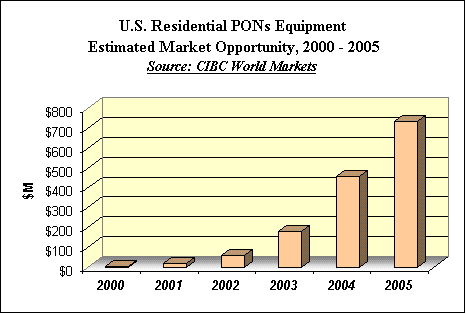The company says its product for residential access based on Ethernet is the fastest yet. Is there a market?
November 29, 2001

Alloptic Inc., a startup specializing in Ethernet-based passive optical networking (PON) gear, says a new product set for unveiling sometime in the next few days will best the competition in the emerging fiber-to-the-home (FTTH) market.
The move is a vote of confidence for PON, a technology that uses passive optical splitters to siphon wavelengths from one fiber to many users. It's also a vote for the use of PONs in residential services, where carriers reportedly see an opportunity to reap revenues by offering so-called converged services, ones that combine voice, data, and video.
Alloptic says its new HomeGEAR 1000, comprising a telco box and home units, will provide up to 1 Gbit/s of optical bandwidth upstream to a maximum of 32 users. The residential unit will feature up to four 10/100Base-T Ethernet ports, two voice circuits, and support for IP video, and radio-frequency CATV links. Pricing will fall between $1,200 and $1,500 per home, Alloptic says.
The vendor says HomeGEAR 1000 is faster than previously announced FTTH PONs. And on the face of it, this appears to be so: FTTH competitors Optical Solutions Inc. and Wave7 Optics Inc. offer aggregate bandwidth of 208 Mbit/s and 500 Mbit/s, respectively.
But this kind of comparison can be misleading. The key to PON technology is not only how much raw bandwidth is available but how that bandwidth is actually put into users' hands. Factors such as power budgets, distance limits, and support for various types of video transmission are a factor.
Skeptics abound regarding the viability of home PON. Carriers such as SBC Communications Inc. (NYSE: SBC) and Japan's NTT Corp. claim to be on track with plans. But so far, nothing solid (read: revenue-producing) has come of it.
Another key problem for vendors such as Alloptic and Wave7 Optics has been that they base their wares on Ethernet and IP, which don't conform to the ATM-based FSAN (Full Service Access Network) specs set by the International Telecommunication Union (ITU). In the past, this has limited their access to key incumbent providers who were at least willing to listen to PON pitches, if not act on them.
Now, Alloptic and its competitors say that's changing, thanks to products like HomeGEAR 1000 that support converged services -- and thanks to the poor economy. Strapped for ways to offer more lucrative services, carriers, including RBOCs, are increasingly willing to look at anything that could help them get ready cash.
"RBOCs have changed. There's much more of a concentration on ROI and fundamentals," says Burnie Atterbury, Alloptic's senior director of product marketing. "Carriers see that PON makes sense from an operating expenditure perspective. It's not a whiz-bang technology, but it's consistent with the market today. It makes sense in the restrictive capex environment."
Alloptic claims to be in field trials with "a few" unnamed carriers. "We are also in discussions with quite a few service providers," says Atterbury [emphasis added].
Other vendors agree that FTTH is a market on the grow. "The RBOCs aren't wedded to FSAN," says Emmanuel Vella, chief marketing officer at Wave7 Optics. "They want a practical approach that's cost effective." He says there's been lots of "disinformation" about PONs in general that's now being dispelled.
"This is a growing market," says Joe Dooley, director of product management at Optical Solutions. "There is a lot of new activity, even from the FCC. There's also a move to push telecom access costs onto the shoulders of subscribers." PONs help do that, he says, by bringing faster ROI and faster revenue generation to carriers than do alternatives like DSL.
Analysts also are climbing aboard the FTTH bandwagon. CIBC World Markets, for instance, has revised its forecasts up. "We [previously] underestimated the independent and municipal market for FTTH," write analysts Alan Bezoza and colleagues in their latest report on the market. The group now sees revenues from U.S. PON gear growing in triple digits for the next three years, and over 80 percent per year after that: Even if RBOCs are willing to listen, however, they continue to move slowly toward adoption of new technologies. In the meantime, the PON vendors say they're focused on other kinds of carriers, including independent providers looking to compete in the cable-based services market. And they say new products such as Alloptic's are clear signs that the market is taking firm steps forward.
Even if RBOCs are willing to listen, however, they continue to move slowly toward adoption of new technologies. In the meantime, the PON vendors say they're focused on other kinds of carriers, including independent providers looking to compete in the cable-based services market. And they say new products such as Alloptic's are clear signs that the market is taking firm steps forward.
— Mary Jander, Senior Editor, Light Reading
http://www.lightreading.com
You May Also Like









